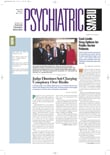Douglas Zatzick, M.D., a young psychiatrist at the University of Washington in Seattle, describes himself as “a combination PTSD researcher and a health services researcher.” And indeed, what Zatzick has been up to recently is trying to get into the minds of the 2.5 million Americans who are hospitalized each year following car crashes, stabbings, or other extreme types of physical trauma.
In essence, he and his colleagues undertook a study to learn what such persons worry about. They decided to conduct a study at a major trauma center in northern California—that of the University of California Medical Center at Davis. Each year, some 2,500 to 3,000 survivors of physical trauma are admitted to this center. Many have been in car crashes or struck by a car while biking or crossing the street. Numerous others have been shot, stabbed, or otherwise physically assaulted.
They randomly selected for their study 97 survivors of physical trauma admitted to this trauma center during 1997 and 1998. They then visited each of the patients shortly after hospitalization to ask them questions about their concerns and to ascertain whether they were suffering from PTSD symptoms and what their physical limitations were. They then called each of the patients at home one month, four months, and 12 months after injury and asked the same questions that had been posed in person at the trauma center. The researchers then analyzed the patients’ responses. The findings were published in the April Medical Care, the official journal of the American Public Health Association.
First off, Zatzick and his colleagues reported that persons who survive serious physical trauma appear to have extensive worries. The patients they studied expressed 497 concerns during the course of the year they were followed. Second, persons who survive serious physical trauma seem to worry about a number of different things. However, the bulk of their anxieties appears to be concentrated on their physical health—say, on whether they will be impaired over the long-term or able to care for themselves; then on psychological concerns—say, depression, substance abuse, or apprehension about disfigurement; and then on work issues—for example, whether they will be able to support themselves and their families financially following their injuries.
Physical trauma survivors, according to Zatzick and his team, also tend to do most of their worrying one month after injury, which is when their PTSD symptoms and physical limitations also tend to peak. And as their PTSD symptoms and physical limitations ease during subsequent months, so do their worries. Even one year after injury, however, many are still not worry free. Indeed, for 60 percent of the patients studied, the major worry they had expressed right after their injuries remained a substantial concern one year later.
The implication of these results, Zatzick told Psychiatric News, is that, after a traumatic injury, PTSD is an incredibly important issue. But there are all sorts of psychosocial concerns that are also relevant. And they could be addressed both by mental health professionals and surgical professionals. We need to start thinking about the delivery of psychosocial and mental health services in surgical wards and in emergency departments for physical trauma survivors.”
When Psychiatric News asked Zatzick whether any mental health services are now being offered to physical trauma survivors in surgical wards or in emergency departments, he replied: “There are sporadic services available on inpatient surgical units. For instance, if someone is psychotic, or quite agitated and disturbing the unit, or in alcohol withdrawal, then clearly a psychiatric consultant will be called. That is standard in most trauma centers. However, if somebody is quietly suffering from high levels of PTSD or depression, it is much less likely that the surgical providers will think that through to detect the disorder and call for an evaluation. . . .”
In short, Zatsick said, “We need to be a little more systematic and rational in how we check in with patients to find out what is disturbing them, whether it be psychiatric or financial or what have you. Psychosocial services could be built around those assessments.”
The study report, “Posttraumatic Concerns: A Patient-Centered Approach to Outcome Assessment After Traumatic Physical Injury,” can be accessed on the Web at www.lww-medicalcare.com by entering “Zatzick” in the “Quick Search” box. ▪
